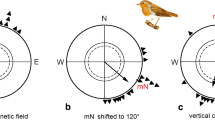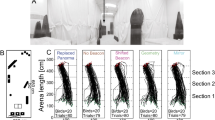Summary
To study the relative importance of piloting by familiar landmarks compared to navigation using a ‘map’ and a compass at familiar sites, 6 h slow shifted pigeons were released under sun at locations from which they had homed more than 60 times before. They showed the typical ca. 90 ° clockwise deviation from the mean of the controls indicating the use of the sun compass.
These findings show that even at very familiar sites the home direction is determined as a compass direction. There is no evidence for piloting, i.e. following chains of familiar landmarks. Another use of landmarks, however, namely their use to recognize a location where the home course is known from previous experience, appears possible.
Similar content being viewed by others
References
Alexander JR (1975) The effect of various phase-shifting experiments on homing in pigeons. PhD thesis, Cornell University, Ithaca, New York
Baker RR (1978) The evolutionary ecology of animal migration. Hodder and Stoughton, London Sydney Auckland Toronto
Batschelet E (1965) Statistical methods for the analysis of problems in animal orientation and certain biological rhythms. American Institute of Biological Sciences, Washington, DC
Benvenuti F, Fiaschi V, Fiore L, Papi F (1973) Homing performances of inexperienced and directionally trained pigeons subjected to olfactory nerve section. J Comp Physiol 83:81–92
Edrich W, Keeton WT (1978) Further investigations of the effect of ‘flight during clock-shift’ on pigeon orientation. In: Schmidt-Koenig K, Keeton WT (eds) Animal migration, navigation and homing. Springer, Berlin Heidelberg New York, pp 184–193
Foà A, Albonetti E (1980) Does familiarity with the release site influence the initial orientation of homing pigeons? Experiments with clock-shifted birds. Z Tierpsychol 54:327–338
Frisch K von, Lindauer M (1954) Himmel und Erde in Konkurrenz bei der Orientierung der Bienen. Naturwissenschaften 41:245–253
Graue LC (1963) The effect of phase shifts in the day-night cycle on pigeon homing at distances of less than one mile. Ohio J Sci 63:214–217
Griffin DR (1952) Bird navigation. Biol Rev 27:359–400
Griffin DR (1955) Bird navigation. In: Wolfson A (ed) Recent studies in avian biology. University of Illinois Press, Urbana, pp 154–197
Hartwick RF, Foà A, Papi F (1977) The effect of olfactory deprivation by nasal tubes upon homing behavior in pigeons. Behav Ecol Sociobiol 2:81–89
Heinroth O, Heinroth K (1941) Das Heimfmde-Vermögen der Brieftauben. J Ornithol 89:213–256
Keeton WT (1969) Orientation by pigeons: is the sun necessary? Science 165:922–928
Keeton WT (1974) The navigational and orientational basis of homing in birds. In: Advances in the study of behavior, vol 5. Academic Press, New York London, pp 47–132
Kramer G (1953) Wird die Sonnenhöhe bei der Heimfindeorientierung verwertet? J Ornithol 94:201–219
Schmidt-Koenig K (1961) Die Sonne als Kompaß im HeimOrientierungssystem der Brieftauben. Z Tierpsychol 18:221–244
Schmidt-Koenig K (1965) Current problems in bird orientation. In: Advances in the study of behavior, vol 1. Academic Press, New York London, pp 217–278
Schmidt-Koenig K (1979) Avian orientation and navigation. Academic Press, London New York San Francisco
Schmidt-Koenig K, Schlichte HJ (1972) Homing in pigeons with impaired vision. Proc Natl Acad Sci USA 69:2446–2447
Schmidt-Koenig K, Walcott Ch (1978) Tracks of pigeons homing with frosted lenses. Anim Behav 26:480–486
Wallraff HG (1974) Das Navigationssystem der Vögel. Schriftenreihe “Kybernetik”. Oldenbourg, München Wien
Wallraff HG (1983) Theoretical aspects of avian navigation. Acta XVIII Congr Int Ornithol, Moskow 1982 (in press)
Wehner R (1972) Visual orientation performances of desert ants (Cataglyphis bicolor) toward astromenotactic directions and horizon landmarks. In: Animal orientation and navigation. NASA SP-262, US Gov Print Off, Washington, DC, pp 421–436
Wiltschko R, Wiltschko W (1981) The development of sun compass orientation in young homing pigeons. Behav Ecol Sociobiol 9:135–141
Wiltschko W, Wiltschko R (1978) A theoretical model for migratory orientation and homing in birds. Oikos 30:177–187
Wiltschko W, Wiltschko R (1982) The role of outward journey information in the orientation of homing pigeons. In; Papi F, Wallraff HG (eds) Avian navigation. Springer, Berlin Heidelberg New York, pp 239–252
Author information
Authors and Affiliations
Rights and permissions
About this article
Cite this article
Füller, E., Kowalski, U. & Wiltschko, R. Orientation of homing pigeons: compass orientation vs piloting by familiar landmarks. J. Comp. Physiol. 153, 55–58 (1983). https://doi.org/10.1007/BF00610342
Accepted:
Issue Date:
DOI: https://doi.org/10.1007/BF00610342




